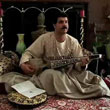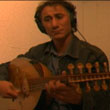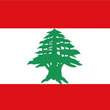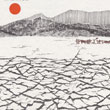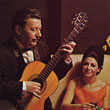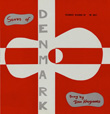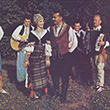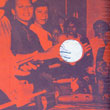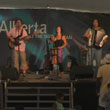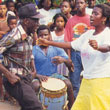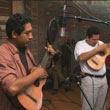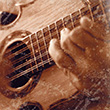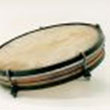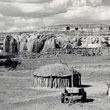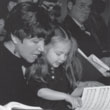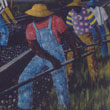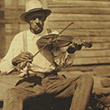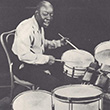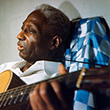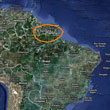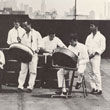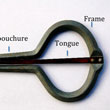Lesson Plans
Free resources for the classroom
Please browse the following map to find world music curricular experiences from Smithsonian Folkways' Network of Music Educators. All lessons can be downloaded in PDF format.
Africa | Asia | Australia and Oceania | Europe | North America | South America | Other
Yes! I Wanna! Learn Music from Botswana!
Country: Botswana
Grades: 3-5; 6-8
In this series of three lessons, students will sing traditional music from Botswana, listen critically to the performance practice and styling of both traditional instruments and singing, and create a game and a composition in the style of the culture.
Country: Egypt
Grades: 6-8
Students will experience the music of the Bedouin culture of Egypt. In the listening example, they will hear two ancient traditional instruments; the rababa, a fretless stringed instrument, and the darabuka, a conical percussion instrument, play music and learn a ancient Egyptian art form, Shadow Puppet Theatre.
Country: Ethiopia
Grades: 6-8; 9-12
Students will be introduced to the music of Ethiopia through several activities including listening, analyzing, and performing. They will perform arrangements on various instruments, playing intact and together, and will use this material to improvise and compose their own music.
Experiences with Ghanaian Music for Middle School General Music Students
Country: Ghana
Grades: 6-8
This lesson is intended to develop knowledge regarding Ghanaian music. Students will experience the musical cultures of Ghana through listening, movement, game play, and percussion performance.
West African Song and Chants: Children's Music from Ghana
Country: Ghana
Grades: 3-5; 6-8
With these segments, teachers are offered opportunities to use children's music from Ghana, West Africa, to gain experience with basic polyrhythmic ensembles. Singing, chanting, dancing and playing instruments are included throughout the unit.
Music of "The Seventh Continent"
Country: Madagascar
Grades: 9-12
Students will learn about the culture and music of Madagascar experientially through learning and performing a traditional song, both vocally and with a band. Students will experience singing in a new language as well as learn about the geography and history of Madagascar.
Tooting the Horn of Africa: A "Cornucopia" of Music from Somalia
Country: Somalia
Grades: 3-5; 6-8; 9-12
Students will become familiar with the music of Somalia by watching and listening to music on oud, drums, and song. These songs will provide repertoire for the students to sing and play as they gain fluency in recognizing, performing, and transcribing the pentatonic scale as well as discussing the history of music in Somalia.
One Flute, Two Flute, Red Flute, Blue Flute: Nigerian-Style Flute Music
Country: Nigeria
Grades: 3-5; 6-8;
These lessons will provide intermediate-level children the opportunity to hear improvised flute performance for solo, duet and octet ensembles. Students will learn to identify diverse musical elements, including steady beats, rhythm, melody, harmony and expressive qualities in an improvised setting.
Braiding Rhythms: The Role of Bell Patterns in West African and Afro-Caribbean Music
Country: Cuba, Puerto Rico, Ghana, Nigeria
Grades: 9–12, college/university courses
These lessons aim to demonstrate the polyrhythmic element found throughout in West African and Afro-Cuban music. Students will listen to music from Ghana, Nigeria, Cuba, and Puerto Rico to learn how this polyrhythmic tradition followed Africans to the Caribbean as a result of the transatlantic slave trade.
The Freedom Songs of South Africa and the Civil Rights Movement in America
Country: South Africa
Grades: 9-12
Students will experience creative musical activities related to the singing South African Freedom Songs and the culture and performance practice behind the music. The lesson segments also seek to provide a direct correlation, musically and historically, to the African American Freedom Songs of the Civil Rights Movement.
Delicious Peace: Music of the Ugandan Mirembe Kawomera Coffee Cooperative
Country: Uganda
Grades: 6–8; 9–12; college/university
The Mirembe Kawomera Coffee cooperative in Uganda is a movement designed to promote the sale of Ugandan coffee, but also to unite several culture groups, including Christians and Muslims, to promote a common cause of world peace. ‘Mirembe’ means ‘peace’ and ‘kawomera’ refers to the high quality nature of the coffee that this co-op sells.
Mbiras, Marimbas, and You: Zimbabwean Music for the General Music Classroom
Country: Zimbabwe
Grades: 3-5; 6-8; 9-12
Learn to play and compose music with the mbira. Explore the use of the instrument in Zimbabwe to understand the relation of music to history and culture and its ability to incite social change. Lesson includes notations, historical background, and recordings and images from Smithsonian Folkways.
Afghan Rubâb: The Lion of Instruments
Country: Afghanistan
Grades: 6-8; 9-12
The Afghan Rubâb is revered as Afghanistan's "national instrument." Despite censorship during the Taliban rule, the rubâb has regained its prominence in the Afghan culture.
Celebrate Cambodia: Khmer Festival and Wedding Music
Country: Cambodia
Grades: 6-8
Through active listening, discussions of cultural context, and re-creating ostinati and pentatonic melodies, students will experience two contrasting examples of the music of the Khmer people of Cambodia.
Discovering the east of China: Chinese music in Elementary School
Country: China
Grades: 3-5
This curricular unit introduces some regional music of China and encourages children to discover characteristics of Chinese music by "travelling" around the eastern region.
Finding the Musical Clues within the Music of the Chinese New Year
Country: China
Grades: 3-5
All songs tell a story. Songs with text make it easier to tell what the story is. What happens when the music is instrumental or the text is in another language that we do not understand? For example, what if the text is in Chinese? We can often find musical clues to help us figure out what story the music is telling us.
Country: India
Grades: 3-5; 6-8; 9-12
Students will experience traditional Indian music and internalize it by moving to it. There will be an opportunity to listen to, play and dance to sitar music and ragas.
Gateway Experiences in the Music of North India
Country: India (North)
Grades: 3-5
Students will be introduced to the music of India with a focus on introductory terminology, elemental concepts, and instrument identification through various singing, listening and playing opportunities.
Being Creative with Hindustani Vocal Music
Country: India
Grades: 9-12
Students learn about Hindustani vocal music and rhythm using a number of Hindustani songs. By the end of the lesson students should be able to sing scales, improvise over a drone, as well as listen to and discuss Indian music.
Country: India
Grades: 6-8
Introduce students to the melodic rhythms of the tabla tarang, classical drumming from India, through music and movement. Learn to improvise the jati system of vocalizing rhythms
Country: India
Grades: 9-12
Talk about the geography, language, and culture of Kerala in South India using story songs, dance dramas, and rhythms. Introduce students to specific artists and instruments important to Kerala's musical traditions.
The Balinese Gamelan Orchestra Club
Country: Indonesia
Grades: 3-5
Students will learn about the music and culture of Bali, Indonesia by listening to recordings and hearing the rhythm of the gong cycle. Students will read a storybook, see pictures of children playing gamelan in Bali, and be able to create a soundtrack to the story by playing along on instruments.
Country: Indonesia
Grades: 6-8, 9-12, and tertiary
Vocal music is a key expression in many cultures. This unit focuses on a selection of vocal music from Indonesia and asks students to explore the ways in the vocal music expresses culture.
Israeli Song and Dance for Middle or High School Ensembles
Country: Israel
Grades: 6-8, 9-12
Students will be introduced to Jewish folk music through singing, playing, and dancing a traditional arrangement of "Al Tiruni" and participating in guided discussions of Jewish history and cultural heritage.
Country: Iran
Grades: 9-12
Listen to various instruments from Iran across different Iranian genres such as classical or pop. Determine the meaning of the lyrics in reference to the culture.
A Day in the Life of a Kurdish Kid
Countries: Iran; Iraq; Syria; Turkey
Grades: K-2
The lesson will introduce children and their teachers to the Kurdish people and their history and culture by leading them on a Kurdish experience full of singing and dancing.
Countries: Iraq; Spain; Turkey
Grades: 3-5
Use video and music to discover the ancient Middle Eastern stringed instrument, the oud. Discuss the history of the instrument and compare different styles of playing. Learn to identify and repeat the different rhythms.
An Introduction to Japanese Music: "Sakura Sakura"
Country: Japan
Grades: K-2
This lesson is aimed at bringing students experiences to Japanese music, including attention to listening to music in a minor key, singing Japanese words, discussing Japanese cultural sensibilities, and using the body to respond to music that moves at a slow tempo.
Soran Bushi: Exploring Japanese Work Song
Country: Japan
Grades: 3-6
Soran Bushi, a Japanese work song, allows for exploration into Japanese culture (work song/environment/nature) as well as exploration in creative composition/ arranging.
Sakura Sakura and the Kumoijoshi Scale of Japan
Country: Japan
Grades: 3-5; 6-8
Discuss Japanese customs regarding spring and the meaning of cherry blossoms. Listen to Japanese and American versions of the same song and discuss the similarities and differences.
Shintaro-san of the Mountain: Mountains, Minyo, and Japanese Culture
Country: Japan
Grades: 3-5
This tutorial provides an introductory view into Japanese traditional ballads or folksongs, known as minyo, and folktales involving the cultural heritage of Japanese mountains. Basic background of Japanese traditional music and Japanese mountain folklore will be discussed; musical activities, experiences, and stories support this lesson.
5,000-year-old Echoes of Humanity: Baalbek, Lebannon
Country: Lebanon
Grades: 3-5; 6-8; 9-12
Students will compare and contrast two types (folk and art) music found in Lebanon, sing and play a simple song in Arabic, and dance the national dance called the Dabke.
The Soul of Korean Arirang: Music from Korea in the Middle School Band
Country: Korea, South
Grades: 6-8
This lesson is designed to enhance the music of John Ployhar's well-known “Korean Folksong Medley” for Concert Band, and should be used as an introduction to Korean folk music before the band arrangement is handed out to students.
Ganggangsullae: Korean Dance Music of the Full Moon
Country: South Korea
Grades: 3-5; 6-8
In this lesson, students will develop an understanding of the mode of Namdo Korean folksongs, as well as the call-and-response musical form. To illustrate these features, this lesson focuses on the 5,000 year-old Korean dance known as "Ganggangsullae".
Two Children's Songs from the Philippines
Country: Philippines
Grades: 3–5; 6-8
This lesson consists of two children’s songs from the Philippines. Students will be exposed to Tagalog language and translation; culture, manners, and geography of the Philippines; 3/4 time, steady beat, dance and movement; unison singing, Orff playing and accompaniment, recorder playing, music theory, and composition.
An Introduction to the Music of Mongolia
Country: Mongolia
Grades: 9-12
Students will be introduced to the music of Mongolia through several activities looking into different aspects of Mongolian music. Students will be introduced to the sound of the Morin Khur (horse-head fiddle), the techniques of Khöömei (throat singing), and given an opportunity to play a traditional Mongolian song with western instruments.
Musical Hooves on the Steppes: The Morin Huur of Mongolia
Country: Mongolia
Grades: 3-5
Explore rural nomadic life in Mongolia and the highly impressionistic music and arts of the Central Asian steppes. Students learn to imitate sounds of the natural environment through improvised dance, instrumental performance, and throat-singing.
An Exploratory Short Course in Tuvan Throat Singing
Country: Mongolia
Grades: 9-12
An introductory course exploring "throat singing" (or overtone singing) as practiced and performed by the people of Tuva. We will explore this truly unique style of vocal production through attentive listening, watching video and practicing techniques and types of throat singing.
Country: Thailand
Grades: 6-8; 9-12
The piece "Man and Buffalo (Kon Gap Kwai)" by Caravan was instrumental in effecting governmental and social change in Thailand. Musical study of the song lends itself to discussions of form, performances of ostinati and accompaniment, and improvisation of a pentatonic song/solo.
Let's Dance Like an Eagle: Zeybek Dance in Turkey
Country: Turkey
Grades: 9-12
Teach the history and geography of Turkey, focusing on the Anatolia region and Zeybek traditions. Students will learn to identify rhythmic patterns in Turkish music and Zeybek dance.
Folk Music of Turkey: The Songs and Dances of Anatolia and the Black Sea
Country: Turkey
Grades: 6-8
Students will be introduced to Turkish style song and dance through listening to, recreating the sounds of, and dancing Bacon is in the Larder.
Experiences with Australian Aboriginal Music
Country: Australia
Grades: 3-12
Students will be introduced to the three pieces of Aboriginal music from the Northern Territory of Australia. They will perform rhythms with body percussion and on rhythm instruments.
Pacific Islander Songs, Sounds, and Signals: Musics of Samoa, Fiji, and Tonga
Countries: Fiji; Samoa; Tonga
Grades: 3-5
Explore the music of these Pacific islands, their instruments and their similarities with other cultures. Practice musical notation by writing down some of the melodies and rhythms; identify the type of instrument used and its meaning.
Paradise Found: Singing and Drumming of Western Samoa
Country: Samoa
Grades: 3-5
This exciting lesson explores the rich sounds of Western Samoa. Students will recreate the beautiful sounds of singable melodies with uncomplicated rhythm. The students will sing, dance, and drum in the traditional community style of Western Samoa.
Let's Polka! The Polka, its function place in different cultures
Countries: Austria; Czech Republic; etc.
Grades: 3-5; 6-8; K-2
Austria: Land of Waltzes & Polkas
Country: Austria
Grades: 3-5
Students will be introduced to the concept of beats in groups of two and three. Balloons, instruments and dancing will be used to explore this concept using the Polka and Waltz.
Countries: Belarus; Russia; Yugoslavia (former)
Grades: K-2
This lesson uses music from Romani performers to explore basic musical concepts. Students show ternary (ABA) form in movement, sing a Russian folk song in English, practice showing phrase structure and finding and showing beat, and discriminate a rhythmic pattern at various tempi.
Danish Music: Tall Tales, Melodies, and Movement
Country: Denmark
Grades: 3-5
This lesson is designed to teach students about aural tradition and the Danish hero Peter “Tordenskjold” Wessel. Students will discuss tall tales and draw parallels to similar characters in American culture. When considering these heroes, they will collaborate and compose new verses. They will play, hand sign, and sing the melody of the song “Tordenskjold” and perform the traditional Danish “Song of Welcome.”
From the Heart of England: Traditional English Songs for Children
Country: England
Grades: K-2
Featured here are three traditional songs from England that call for opportunities to sing, move, and listen attentively. Each song offers young children the opportunity to be creative in their physical expressions while also following direction in a sequential order.
Eine Kleine Kindermusik: Children's Songs from Germany
Country: Germany
Grades: 3-5
Students are invited to sight-read (solfege), play recorder, listen critically, and create, all in exploration of traditional German children's songs.
Irish Music: Experiences in Dance, Singing, and Instrument Playing
Country: Ireland
Grades: 3-5
Explore the world of Irish culture through playing, singing and dancing. Students will learn to differentiate styles of Irish music and start discussing the cultural context of song and dance.
Country: Ireland
Grades: 9-12
Orchestral students can experience traditional Irish culture through their involvement in song analysis, improvisation, and instrument demonstrations. The listening activities will allow students to practice "meter detection" and instrument identification.
An Introduction to Irish Music
Country: Ireland
Grades: 9-12
Explore Irish and Irish-American history and culture through song lyrics, dance, and instrument demonstrations. Follow the music and play along with melody sheets and band transcriptions.
Irish Bodhran and the Celtic Classics: Singing, dancing and playing
Country: Ireland
Grades: 3-5; 6-8
Students will learn to play the bodhran accurately and with a steady beat. Learn listening, singing and dancing skill through the traditional song "Cunla"
From Tarantella to Tyrol: a Tour of Italian Folk Music
Country: Italy
Grades: 3-5; 6-8
This unit is a survey of regional differences in Italian folk music. Students will contrast styles of southern and northern Italy through attentive listening, moving, instrument playing and singing.
Singers to the Core: Folk Music from Latvia
Country: Latvia
Grades: 3–5; 6–8; general music or choral
In this series of three lessons, students will engage with Latvian folk music, culture, and history through critical listening, singing, movement, dance, and instrumental performance.
Northern Lights: Journey North to Norway
Country: Norway
Grades: 5-7
Experience Norwegian folk music through a journey north to the land of the fjords and Hardanger fiddles. Students will have an opportunity to listen, discuss, and play Norwegian folk songs.
From Russia with Love: Russian Folk Music on the Balalaika
Country: Russia
Grades: 3-5; 6-8; 9-12
Students will listen to and play Russian music, with an emphasis on the balalaika and accordion. They will also play “Tachanka”, a Russian folk tune, in parts.
Can You Kolo? Songs and Dances from Old Yugoslavia
Country: Serbia and Croatia
Grades: K-2, 3-5, 6-8
In this unit, students will listen to music from Serbia and Croatia. They will identify the traditional instruments used in this music, including tamburitza, frula, and accordion.
An Exploration of Spanish Music and Dance Traditions
Country: Spain
Grades: 3-5
These lessons are designed to introduce some of the history, traditions, and music of Spain. The first of the three lessons covers the flamenco dance and discusses the Romani (Gypsy) people. The second lesson is designed to teach students a fun Spanish children’s song. The third lesson introduces some of the Christmas traditions in Spain as well as a villancico (Spanish Christmas carol).
Beats, Rhythms, and Drums: Grooves of the World
Country: Bahamas, United States
Grades: K-2
We are all born with the rhythm inside us, our hearts thumping out an ongoing, ever-present beat that is individually felt and yet also commonly experienced. Through these experiences, children will discover the commonalties shared in drum beats and rhythms across cultures, as well as learn about the rich diversity of drums on the planet.
Music from the Edge of Civilization: Inuit Music for the Classroom
Country: Canada
Grades: 6-8; 9-12
Students will experience the music of the Inuit culture in Canada by participating as percussionists and wind players, mimicking a common song in the marketplace. In the listening example, they will hear two women performing an ancient and difficult sort of musical game called “Throat Singing.” They will demonstrate their learning by attempting their own throat singing.
Allo, Monsieur! French Canadian Children's Songs
Country: Canada
Grades: K-2
This unit affords teachers with opportunities to lead children in active singing games and dances from Quebec, Canada. These lessons will offer young singers and players an opportunity to listen to, discuss, sing, play games, and create.
Zydeco est Gumbo: And Introduction to Zydeco Music
Countries: Canada; Haiti; United States
Grades: 1-2
Students will be introduced to the concept of beats in groups of two and three. Balloons, instruments and dancing will be used to explore this concept using the Polka and Waltz.
Modern Ritual and Contemporary Play
Countries: Canada; United States
Grades: 6-8; 9-12
Music of the Coastal Native American regions spans a geographically and musically vast landscape of indigenous tradition.
Music of Cuba and the Caribbean
Country: Cuba
Grades: 3-5
Students will learn and perform the songs “Guantanamera,” and “Caribbean Carnival” with improvisation. Listening, analyzing and comparing traditional songs from Cuba and the Caribbean will allow students a window into the culture of these countries.
Fish Tales: Exploring the Folk Music of Newfoundland
Countries: Canada
Grades: 4–5
In this series of lessons students will learn about the culture and economy of Newfoundland, learn to sing the folksongs “I’s the B’y” and “Jack Was Ev’ry Inch a Sailor,” learn a folk dance, play recorder and hand chimes, and create a dramatic play.
Countries: Cuba; Haiti; Puerto Rico; Saint Kitts and Nevis
Grades: 9-12
Learn about Caribbean peoples, languages, geographies, and values by singing and playing instruments to Caribbean music. Particular focus on Puerto Rico, Cuba, Haiti, and St. Lucia.
Spirits Across the Ocean: Yoruban and Dahomean Cultures in the Caribbean Brought by the Slave Trade
Countries: Benin, Haiti, Cuba, Trinidad, and Brazil
Grades: 6–8; 9–12
This lesson explores the journey of the African people from the Yoruban and Dahomean cultures to the Caribbean through the forced migration of the trans-Atlantic slave trade. Students will learn about the similarities of the music found all over Latin America in the countries Haiti, Cuba, Trinidad, and Brazil.
Latin American Protest Songs: New Song of Chile & Cuba
Country: Chile and Cuba
Grades: 9–12, college/university
Students will learn about the music of the New Song movement by engaging with the melodies, rhythms, and lyrics of four selections from the Cancion Protesta: Protest Songs of Latin America album. This will teach them about the role music can play in social protest, as well as the specific historical, political, and cultural contexts of the songs.
Music of Chorti Indians of Guatemala
Country: Guatemala
Grades: 5-6; 7-8
This unit contains a total of three lesson plans, which focus on marimba music of indigenous people of Guatemala. Activities include attentive, engaged listening experiences, which lay the groundwork for actually performing an arrangement of the listening example. A video segment provides a springboard into a discussion of marimba music in the context of Guatemalan cultures.
Jamaican Song, Dance, and Play: Experiences with Jamaican Musical Traditions
Country: Jamaica
Grades: 3-5
This lesson is intended to develop knowledge about certain aspects of Jamaican music and culture. Students will experience glimpses of Jamaican culture through listening, performance, game play, and discussion.
The Sound of an Island: Jamaican Music for the Classroom
Country: Jamaica
Grades: 3-5
Students will be introduced to the music and history of Jamaican culture through performing various game songs and dances, as well as playing simple songs transcribed for the recorder.
The Fandango in Son Jarocho: The Community Tradition and Improvisation of Son
Country: Mexico
Grades: 3-5; 6-8
The fandango community celebration is central to the son jarocho tradition of Veracruz, Mexico. This lesson explores the core elements of the fandango: instruments, voice and verse, and rhythmic dance.
Chips and Salsa: A Taste of Mariachi Music for the High School Orchestra
Country: Mexico
Grades: 9-12
Students will learn about mariachi music by listening to individual instruments within the ensemble and imitating them by ear, and through playing an arranged mariachi piece. Extensions can lead to analysis of formal elements within the music, further study of the culture from which this music originates, or contact with culture-bearing mariachi musicians.
Son Jarocho from Veracruz: Exploration of Music and Dance Forms
Country: Mexico
Grades: 3-5; 6-8; 9-12
Use lively recordings and videos from celebrated son jarocho performers José Gutiérrez & Los Hermanos Ochoa to explore regional Mexican folk music and culture. Discuss poetic structure in song lyrics. Translated lyrics improve Spanish language skills.
Mariachi: Music from the Heart of Mexico
Countries: Mexico; United States
Grades: 3-5; 6-8; 9-12
Student will study mariachi by singing, moving, listening, and playing the song "Si no dejan" There is a general-music lesson plan built on videos from the Smithsonian Folkways collection that lead to student learning of music and culture of mariachi music.
Country: Puerto Rico
Grades: 3-5, 6-8
Puerto Rican culture is a representation of the diverse heritages of three main cultural groups: Taíno Indians, Africans, and Spaniards. This lesson focuses on the African influences found in Puerto Rico’s musical culture by studying bomba music.
Country: Puerto Rico
Grades: 3-5; 6-8
Puerto Rican culture is a representation of the diverse heritages of three main cultural groups: Taíno Indians, Africans, and Spaniards. This lesson focuses on the African influences found in Puerto Rico’s musical culture by studying bomba music.
Jíbaro Hasta el Hueso: Jíbaro to the Bone (Jíbaro music of Puerto Rico)
Country: Puerto Rico
Grades: 3–5; 6–8
This unit focuses on the jíbaro music of Puerto Rico. Students will learn to identify the characteristic instruments, rhythms, and sound of jíbaro music, as well as appreciate the improvisatory skills of the poet/singers known as trovatores.
Plena, the People's Newspaper: Puerto Rican Music for the Classroom
Country: Puerto Rico
Grades: 9-12
Maps, music and video-recordings can be effectively used to discuss the present and historical incidence of the plena. In the way that rap music is referred to as “the people's CNN”, plena, an Afro-Puerto Rican musical form that has much in common with other Caribbean musical expressions, is sometimes referred to as “the newspaper of the people” as it expresses what is going on in the lives of working class people.
Jíbaro to the Bone! Puerto Rican Music for the Classroom
Country: Puerto Rico
Grades: 9–12, college/university
This lesson is intended to develop musical and literary skills using jíbaro music from Puerto Rico. In a series of three lessons, students will learn typical instrumentation and forms, augment their vocabulary, and listen to the lyrics in jíbaroas a means of understanding modern Puerto Rican culture.
Country: Puerto Rico
Grades: 2-5
Puerto Rican culture is a representation of the diverse heritages of three main cultural groups: Taíno Indians, Africans, and Spaniards. This lesson focuses on the African influences found in Puerto Rico’s musical culture by studying bomba music.
Braiding Rhythms: The Role of Bell Patterns in West African and Afro-Caribbean Music
Country: Cuba, Puerto Rico, Ghana, Nigeria
Grades: 9–12, college/university
These lessons aim to demonstrate the polyrhythmic element found throughout in West African and Afro-Cuban music. Students will listen to music from Ghana, Nigeria, Cuba, and Puerto Rico to learn how this polyrhythmic tradition followed Africans to the Caribbean as a result of the transatlantic slave trade.
Bluegrass Music: A Toe-Tapping Exploration of an American Art Form
Country: United States
Grades: 3-5
Students will be introduced to American Bluegrass music and Appalachian songs through singing, listening and conversation. A number of songs will be compared leading to a conversation the characteristics of traditional American music.
The Vocal Blues: Created in the Deep South of the U.S.
Country: United States
Grades: 6-8; 9-12
Learning 12-bar blues form though singing and theory provides students a medium for discussion of the blues. Students will have the opportunity to write and perform their own 12-bar Blues verses.
Conjunto Music from South Texas
Country: United States
Grades: 3-5; 6-8; 9-12
Use songs and social dances from the Mexico/USA border to introduce students to South Texas people, language, location, and values. Also discuss issues such as immigration and experiences of living in the borderlands.
American Indian Music: Navajo Culture
Country: United States
Grades: 6-8
Student will learn about Navajo music while gaining a cultural awareness of the culture. Learn to sing and dance to traditional melodies as well as try your hand at composing and improvising to an American Indian Song.
Belly Dance, USA: Music, Movement, and Arab-American Communities
Country: United States
Grades: 6-8; 9-12
This lesson examines belly dance music, performed by Lebanese-American musician George Abdo, an example of music in Arab American communities during the 1970s. Students will learn about Middle Eastern music, its transformations in the United States, and basic forms of belly dance movement.
“I've Got a Friend in Chicago”
Country: United States
Grades: k-2
This lesson is intended to identify and explore children's culture in the United States. In sharing this music in the classroom, students will begin to recognize the importance of their music making and the process of preserving sound. Students will listen to, analyze, and perform music created by children in the United States and for children by American folk artists.
African American Music: Let's Sing and Play Clapping Games
Country: United States
Grades: K-2
Students will learn hand-clapping games from the African American tradition to learn movement, listening and rhythm skills. Explore the role of children's games in African American culture and around the world.
Country: United States
Grades: 3-8
Students learn the four shapes used in Sacred Harp singing and “sing the shapes” of “Yankee Doodle.” In a key appropriate to their voices, they sing the melody part of “Chester,” a Revolutionary-era tune by William Billings. If they are old enough and able to do so, they try a two-part version, melody and harmony.
The Blues — a Gateway into Improvisation
Country: United States
Grades: 6-8
Jazz is at the heart of American music. At the heart of the style, and more importantly listening to and appreciating Jazz, is an understanding of improvisation. To those with limited musical experience, an understanding of improvisation is often extremely difficult and even frightening, that music is seemingly "made" in a spontaneous manner.
Oh, John the Rabbit: From Story to Song
Country: United States
Grades: 2-6
Students will learn to appreciate the process of telling a story through song, while learning basic musical skill like rhythm, singing on pitch, and call-and-response format. The featured song is “Oh, John the Rabbit,” a traditional story-song about a Rabbit that steals all the vegetables from the garden. The song and video is performed by Elizabeth Mitchell, her family, and friends and is from her 2010 album Sunny Day.
Singing for Justice: Following the Musical Journey of “This Little Light of Mine”
Country: United States
Grades: 4-8
This unit affords teachers with opportunities to lead children in active singing games and dances from Quebec, Canada. These lessons will offer young singers and players an opportunity to listen to, discuss, sing, play games, and create.
An Island Soundscape: Musics of Hawai'i, the Solomon Islands, and Papua New Guinea
Country: United States
Grades: 6-8
Discover the island cultures of the South Pacific and their musical expressions with songs, crafts, and games. Uses recordings of Hawaiian slack key guitar, rhythmic game songs from the Solomon Islands, and Papua New Guinea flute playing.
Trail of Tears: Music of the American Indian Diaspora
Country: United States
Grades: 5-8
The segments of this unit offer an investigation of the impact of circumstance on the music of a people through examination of several musical selections from the Five Nations heritage (Choctaw and Cherokee in particular) during and following the Trail of Tears of 1831 and 1838 respectively.
A New Day for Old Time Music from the South
Country: United States
Grades: 6-8
In this introductory lesson students will discover the string band music of the southern Appalachian Mountains, which evolved during the reconstruction period following the Civil War, 1864 - 1880. Students will explore “Old Time” music through listening to archival recordings, dancing to the music, playing guitar and singing a song from the period.
Songs, Sounds and Stories from the Georgia Sea Islands
Country: United States
Grades: 3-5; 6-8; 9-12; K-2
In this set of lessons, students will learn about the Gullah culture in the United States. Through lessons utilizing polyrhythms and call-and-response, critical listening and language skills, musical play, vocal improvisation, and the 12-bar-blues, students will discover the rich traditions of the Gullah culture that have helped to shape our American musical culture today.
Having Our Say: The Music of the Mardi Gras Indians
Country: United States
Grades: Tertiary
This unit is intended to introduce students to the culture and music of Mardi Gras Indians, an important African American phenomenon that takes place in New Orleans. Students will examine the tradition and its culture-bearers, listen to and analyze Mardi Gras Indian music, and examine the multiple cultural influences that have contributed to the tradition.
Moccasin Madness! Navajo and Apache Moccasin Game Songs
Country: United States
Grades: 3-5
Moccasin Game songs of the Navajo and Mescalero Apache tribes are little known outside these cultures, but hold intrigue and understanding for those who pursue the experiences noted here. Students will learn the cultural significance, key traits, and pure joys of playing Moccasin Game songs.
The Power of Pete Seeger's Songs and Stories
Country: United States, South Africa, India
Grades: K-2
Open the eyes of your students to the beauty and power of American and world folk songs and stories through the iconic figure of Pete Seeger. Explore his important work in promoting peace, understanding, community, and wonder through song.
Josh Thomas' Roustabout: Exploring Composition Using Limited Tones
Country: United States
Grades: 4-8
Students will use Mike Seeger’s performance of “Josh Thomas’s Roustabout” as a gateway to exploring vocal expression within a limited-tone sequence.
Protest Songs: A Musical Introduction
Country: United States
Grades: 6-8
Through singing and listening to famous protests songs students will learn to discuss the musical significance as well as the social and historical context of these songs.
Country: United States
Grades: Pre K – K
In these two lessons, accompanied by music from Get Moving with Ella Jenkins, young students can develop comfort singing, clapping, and moving along with musical tracks, while also developing an understanding of basic musical concepts (beat, volume, notes, and rests).
Blending African and Irish Sensibilities in Virginia's Music
Country: United States, Nigeria, Ireland
Grades: 3-5, 6-8
Old-time music has descended from the blending of instruments and traditional expressions. This unit features listening and movement, as well as activities to explore and respond to this music tradition.
Singing In the Harvest: Music from the Zuni
Country: United States
Grades: 3-5
This lesson plan explores the life and music of the Pueblo people of the Zuni in the New Mexico region of North America. Colorful and rich in artistic skills, the Zuni bring joyous communal and personal music-making to life.
Country: United States
Grades: 5-12
This lesson provides an introduction to the drum set and its history and enables students to perform preliminary New Orleans brass band and early jazz rhythms for the instrument.
Country: United States
Grades: 3-5; 6-8; 9-12; K-2
The following is a study of a musical piece of the rich cultural heritage of some of the early settlers of Pennsylvania known as the Pennsylvania Dutch. This study can be a vehicle for musical experiences through singing, notating, creating and analyzing to music.
The Underground Railroad: A Musical Journey to Follow the Drinking Gourd
Country: United States
Grades: 6-8
The following is designed for middle school orchestra (also easily adaptable to middle school general music) students including experiences in creative musical activities and the historical and socio-cultural impacts of slavery on African and American cultures.
Lead Belly and His Legacy of Southern Song
Country: United States
Grades: K-2, 3-5, 6-8, 9-12, C/U
This unit of four stand-alone or progressive lessons celebrates Lead Belly, a Louisiana-born songster who remembered, invented, and passed on a legacy of songs that opens ears and minds to the world of the American south in the late nineteenth century and first half of the twentieth century.
Animals in Song - Elizabeth Mitchell: Animal Songs for Children
Country: United States
Grades: Pre-K, K-2
Students will learn the process of telling a story through song, while learning basic musical skills like rhythm, beat, movement, dance, singing on pitch, and call-and-response format. The featured songs are “Froggie Went a Courtin,” “Arm and Arm,” and “The Little Bird,” from Elizabeth Mitchell’s album Blue Clouds.
Country: United States
Grades: 3–5
This set of lessons is an introduction to African-American music in Alabama through children’s songs of the 1950s as well as freedom songs of the 1960s. In addition to attentive listening, students will sing, play instruments, improvise, move, and play games.
Hootenanny, Hootin’ Annie, Will You Dance with Me? Music of the American Folk Music Revival
Country: United States
Grades: 4–6
This lesson is intended to introduce students to the music of the American folk revival that developed between the 1940s and 1960s with notable figures such as Pete Seeger, Burl Ives, Jean Ritchie, Paul Robeson, and many others.
Bluegrass Music: Chopping and Singing Songs of Sorrow
Country: United States
Grades: 9–12, college/university
This lesson is intended to introduce students to the style and feel of American bluegrass music. Students will be introduced to bluegrass music through exercises that emphasize important components of the genre, including feel, form, and common themes. Lesson segments are designed to stand alone, but a progressive study would lend itself to a more complete understanding of the genre as a whole.
Country: Argentina
Grades: 6-8
The goal of the lesson is to introduce students to two contrasting dance traditions from Argentina, the Chacarera, and the Tango. Elements of the music used to accompany both types of traditional dance will be explored.
Capoeira: Martial Arts Meets Music
Country: Brazil
Grades: 6-8
Performance videos and live recordings immerse students in this musically and visually exciting tradition from Brazil. Students learn to recognize the differences in several Brazilian musical genres.
Ritmo Embolada: An Introduction of Brazilian Rhythm
Country: Brazil
Grades: K-2
“Embolada” is a form of poetry and song that has set refrains. The refrains allow singers to organize their next improvised stanza in their heads, even as the music is sounding. (McGowan,1991) This form of traditional music is active in the northeastern region of Brazil.
Dança!: Movement and Music of Brazil
Country: Brazil
Grades: 3-5; 6-8; 9-12; K-2
Immerse yourself in the lively mood of Samba and Carimbo. Learn the basic steps and dance along with the music. Identify the instruments and play along with others. Learn about the relationships of of Samba and Carimbo with other musics such as jazz and swing.
Bonkers for Bailecitos in Bolivia
Country: Bolivia
Grades: 6-8, 9-12
In this series of three lessons, students will exercise critical listening, singing, dancing, and playing instruments to traditional music of Bolivia. They will improvise rhythms, compose a song, and draw connections across a wide variety of disciplines.
On the Plains of Orinoco: Joropo Music in Colombia
Country: Colombia
Grades: 6-8; 9-12
This lesson investigates life on the Colombian Orinoco Plains through the exploration of joropo music. Activities include Spanish attentive listening, cultural enrichment, and musical interaction through singing, playing and moving.
Musical Gumbo: A Whole Lotta Creole, Cajun and Zydeco Goin' On
Country: French Guiana, Suriname, United States
Grades: 3-5, 6-8
This unit of study is intended to develop student knowledge of the Creole influence on the music of various countries in the Americas: French Guiana, Surname, and the United States. Students will enjoy experiences in listening, singing and playing on instruments, and they will learn to study how different groups of people have influenced one other.
Colorful Genres in Harp music from Paraguay
Country: Paraguay
Grades: 3-5
The Paraguayan harp is a cultural emblem that represents not only the nation of Paraguay and its traditional music, but also the ideals that contribute to a collective notion of paraguayidad (i.e. "Paraguayness"). The Paraguayan diatonic harp serves as a melodic, harmonic, and rhythmic instrument. Its primary function is to provide harmonic and rhythmic foundation to conjunto music—music of a variety of instruments.
Country: Peru
Grades: 6-8; 9-12
Peruvian Aymara Ensemble (Session 1)/Kena (traditional Andean flute) Concerto performed and composed by Peruvian musicians (Session 2) with the cultural and historical introduction.
Music from Saramaka: Maroon Life
Country: Suriname
Grades: 4-5; 6-8; 9-12
The lesson segments provide students with an opportunity to learn of the music of the people of the Maroon lands in Suriname. A song becomes a window for understanding the history and culture that was created by runaway slaves in this place within a South American rainforest. The students will then use the song as basis for their own lyrical and body percussion creations.
Celebrating Trinidadian Steelband Music!
Country: Trinidad and Tobago
Grades: 6-8; 9-12
Through photos, recordings, videos, and playing instruments, students will explore the steelband tradition of Trinidad and Tobago. In the first two segments, they will learn and demonstrate understanding of the basic aspects of steel band music, culture, and history. In the third segment, students will play in this style on their own string instruments.
Catch the Calypso beat and put it on your feet!
Country: Trinidad and Tobago
Grades: 9-12
In this lesson students will travel to the island of Trinidad to explore the feel of Calypso music and participate in a Trinidadian popular dance, the Limbo. Students will be able to perform a Calypso rhythmic pattern on classroom instruments and will accompany their own Limbo dance on Orff instruments while exploring the social and cultural context of Calypso music.
Steel band Style, Calypso Culture and Childhood Chants
Country: Trinidad and Tobago
Grades: 3-5; 9-12
Discover calypso music and culture from the Caribbean country of Trinidad and Tobago through interactive and fun activities. Listen to the music, identify and discuss steel pans and the stylistic elements that give this music its flavor.
The Complete Evolution of Trinidadian Pan Music... Abridged.
Country: Trinidad and Tobago
Grades: 9-12
Students will be exposed to opportunities for tracing the development of West African drumming, to Trinidadian tamboo bamboo, to the invention of the pan, to modern day pan ensembles through listening, identifying, recreating, and orchestrating these various musics.
The Jew's Harp: Vibrating Through Many Cultures
Country: United States, Ireland, Tuva, Papua New Guinea
Grades: 3-5; 5-6
The Jew's harp is played in many cultures around the world. Students learn about the different roles of a Jew's Harp from dance music to musical speech. Students also learn about the history, styles, and origin of this interesting instrument.
Nobel Voices for Disarmament: 1901-2001
Grades: 7-12
Listening to Voices on a World History of Violence. Thinking and Yearning for Peace.
Country: United States
Grades: K-3
In this lesson are opportunities for teaching and learning about some ways in which music is aligned with visual art. A sampling of songs from Smithsonian Folkways Recordings is presented, alongside the cover art relevant to the songs. Several well-known pieces are featured from the wide array of recordings first envisioned by Folkways Record' founder Moses Asch in the 1940s.
Grades: k-12
The lessons in this issue introduce students to the rhythms of poetry. The focus is on two poetic forms that originated as forms of song: the BALLAD stanza, found throughout British and American literature, and the BLUES stanzas of Harlem Renaissance poet Langston Hughes. The exercises take poetry off the page and put it into terms of movement, physical space, and, fi nally, music.




 view cart
view cart












